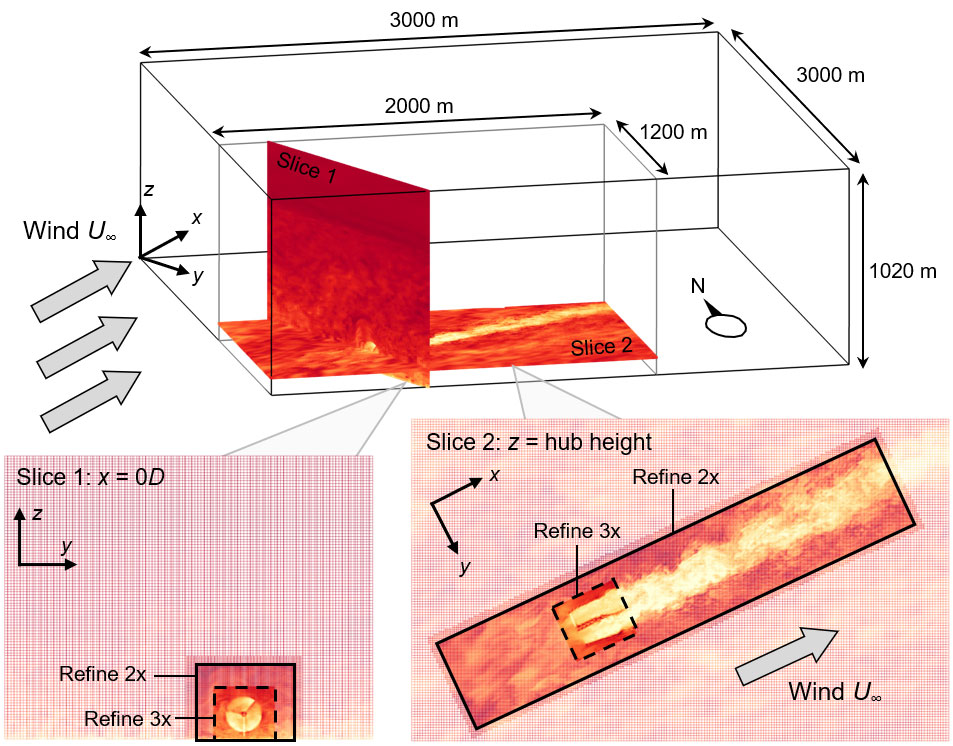News
Supercomputer Simulations Help Optimize Floating Wind Farms
Published September 17, 2019
Over the past few years, offshore wind farms have emerged across the world as a viable source of energy. While these powerful floating wind turbines are typically more than 800 feet tall and weigh over a ton, they reduce land-use concerns, access better offshore wind resources, and can generate more power than land wind turbine farms. However, they present a complex engineering design problem: how can they be optimized to operate in the uniquely challenging offshore environment?
In a Journal of Physics: Conference Series paper published this summer called Large eddy simulations of floating offshore wind turbine wakes with coupled platform motion, researchers from the University of Massachusetts Amherst and the National Renewable Energy Laboratory (NREL) discussed their efforts to advance our knowledge of this issue.
Specifically, the Comet supercomputer at the San Diego Supercomputer Center (SDSC) and the Stampede2 supercomputer at the Texas Advanced Computing Center (TACC) were used to perform simulations that showed how floating turbine wakes are very similar those of fixed-bottom turbines, except that floating turbine wakes are deflected upward and have slightly stronger turbulence at the edge of their wakes.
The collaborative study aimed to better understand how the wake effects of large wind farm arrays decrease power output and reduce the lifespan of the turbines. Because of the growing prospect for floating wind farms, the researchers focused on the differences between floating turbine wakes and fixed turbine wakes.
“We looked at how these wake effects can be accurately considered when designing floating offshore wind farms,” said lead author and National Science Foundation (NSF) Graduate Research Fellow Hannah Johlas. “At about 20,000 computer processor hours, these high-fidelity large eddy simulations are very computationally intensive and expensive, and as such, this research can only be performed using supercomputers.”

Large eddy simulations of the wake behind a floating offshore wind turbine. Domains for simulating the turbine wake (small domain) and the surrounding atmospheric conditions (large domain) are shown. Credit: Hannah Johlas, University of Massachusetts Amherst
The large eddy wind turbine simulations were completed with Comet and Stampede2 using the computational fluid dynamics software Simulator fOr Wind Farm Applications (SOWFA), coupled with the wind turbine modeling tool OpenFAST for the platform and turbine motion. The downstream wake characteristics of the floating platform were compared to equivalent fixed platform cases for different wind speeds, wave heights, wind-wave alignments, and turbine yaw angles.
Overall, the differences in wake shape between floating and fixed platforms were associated with mean platform displacements, while differences in turbulence were associated with time-varying platform motion. However, these observed wake differences between fixed and floating platforms were found to be quite small, especially for higher wind speeds and lower wave heights.
“With global-installed capacity of offshore wind increasing from 8.9 gigawatts in 2015 to 22.5 gigawatts in 2018, this research is becoming even more prevalent and now that we know more about how wakes behave for floating turbines, we will examine how those floating-turbine wakes affect downstream turbine power generation and structural loading,” said Johlas, who has focused her Ph.D. in mechanical engineering at the University of Massachusetts at Amherst on this project. “Comet and Stampede2’s reliability and computing environment flexibility helped complete this research in a time-efficient manner.”
The research was funded by an NSF Graduate Research Fellowship, grant #1451512. The project used the Extreme Science and Engineering Discovery Environment (XSEDE) program funded by NSF grant #ACI-1548562, as well as NREL computational resources sponsored by the Department of Energy’s Office of Energy Efficiency and Renewable Energy.
About SDSC
Located on the University of California San Diego campus, SDSC is considered a leader in data-intensive computing and cyberinfrastructure, providing resources, services, and expertise to the national research community, including industry and academia. Cyberinfrastructure refers to an accessible, integrated network of computer-based resources and expertise, focused on accelerating scientific inquiry and discovery. SDSC supports hundreds of multidisciplinary programs spanning a wide variety of domains, from earth sciences and biology to astrophysics, bioinformatics, and health IT. SDSC’s petascale Comet supercomputer is a key resource within the National Science Foundation’s XSEDE (Extreme Science and Engineering Discovery Environment) program.

